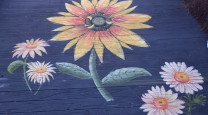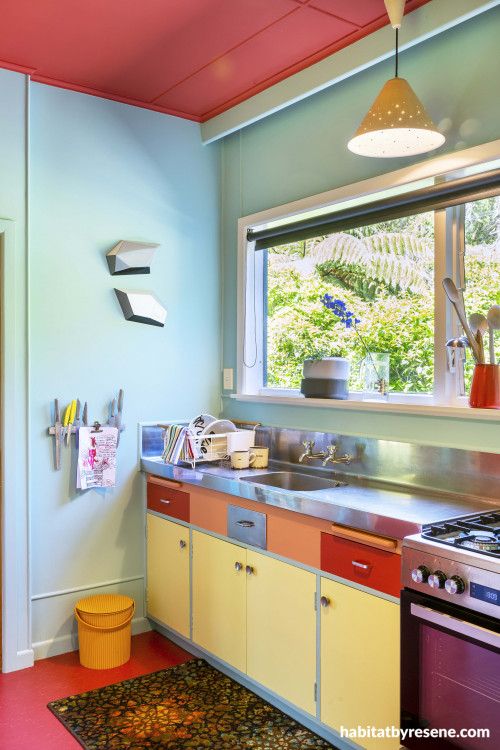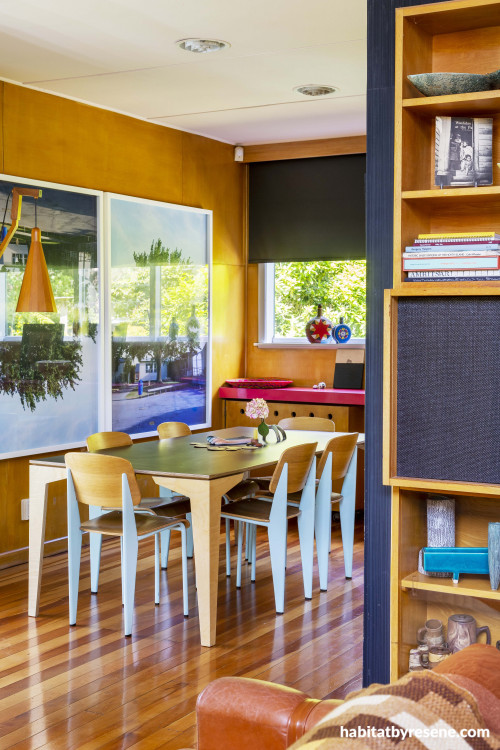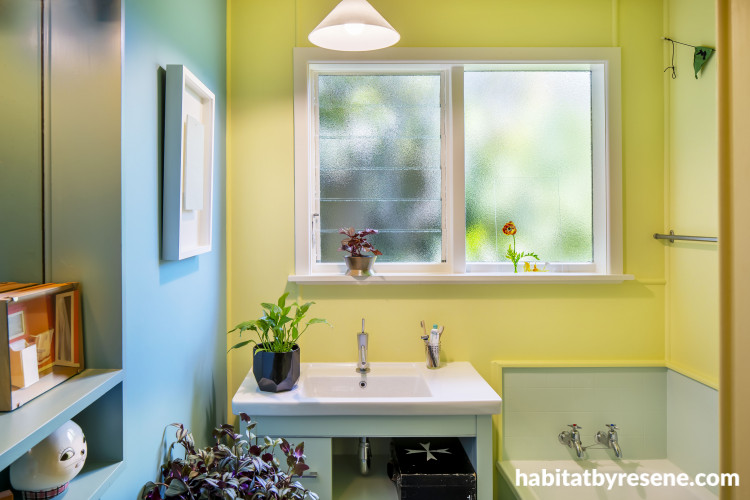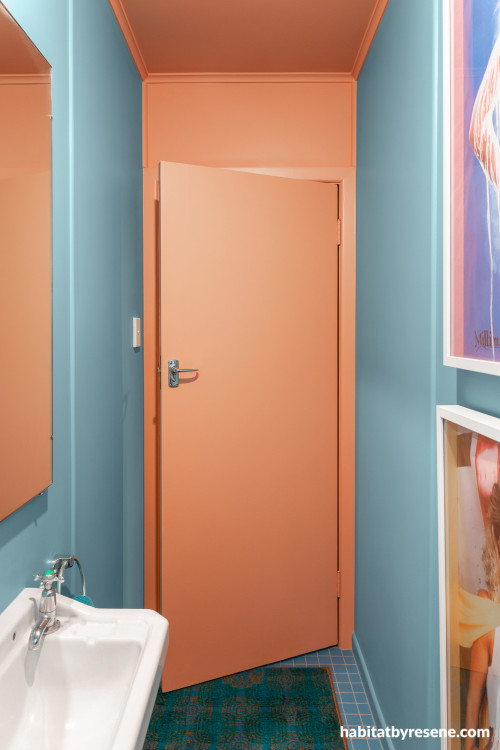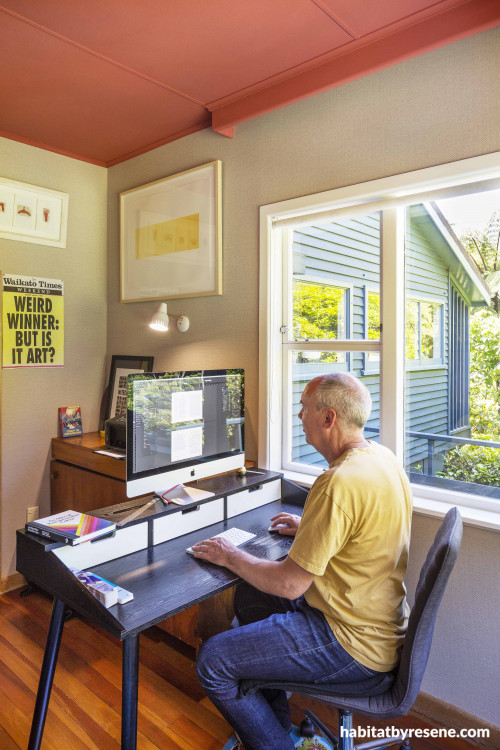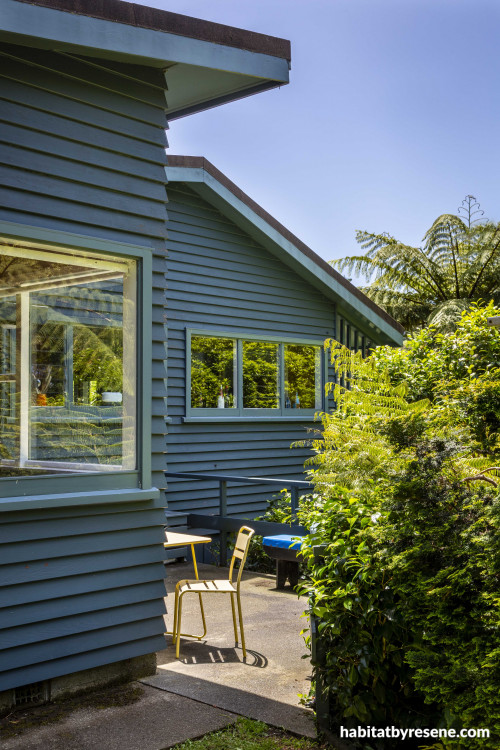A symphony of colours: Bauhaus inspired makeover in Wellington
Inspired by a woman they had never met, the homeowners of this 1950s home embarked on a colourful journey through time.
Visitors to Ann Shelton and Duncan Munro’s Wellington home often have a physical reaction to their home of many colours. Guests take a step back and gasp at the sheer vibrancy of it all, as if the coral pinks, sunny oranges, lemon sherbet and baby blue shades are affecting them on a cellular level.
The home’s bold Resene colour scheme is a shared vision, a collaboration between the home’s original owner, Nancy Martin and Czech Republic-born architect, Frederick Ost, who designed the home in 1957. More than 60 years later, using Resene paints and colours, Ann and Duncan painstakingly brought Nancy and Frederick’s original colour concept back to life.
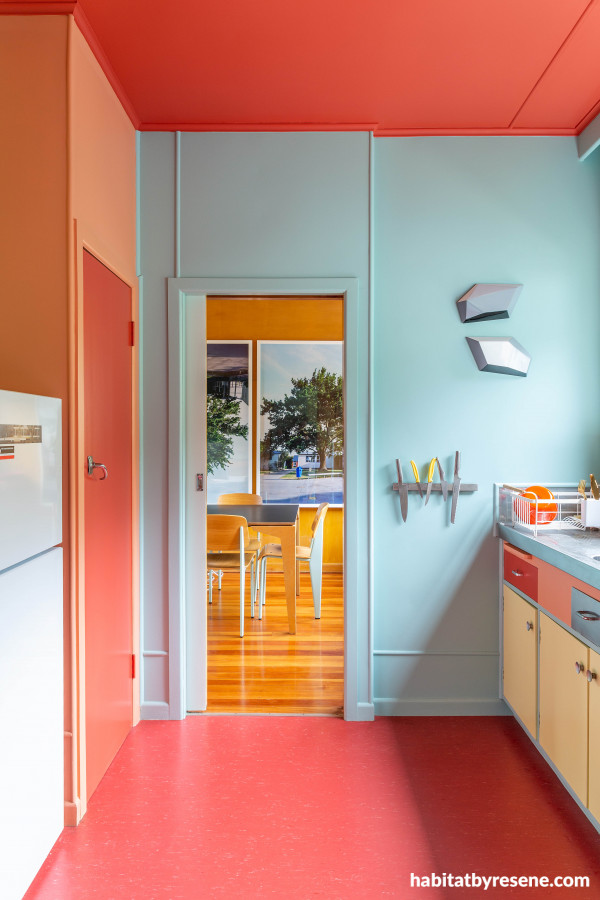
Resene Mexican Red is painted on the ceiling and floor, Resene Burning Sand is on the left wall and Resene Shadow Green on the wall leading to the dining area.
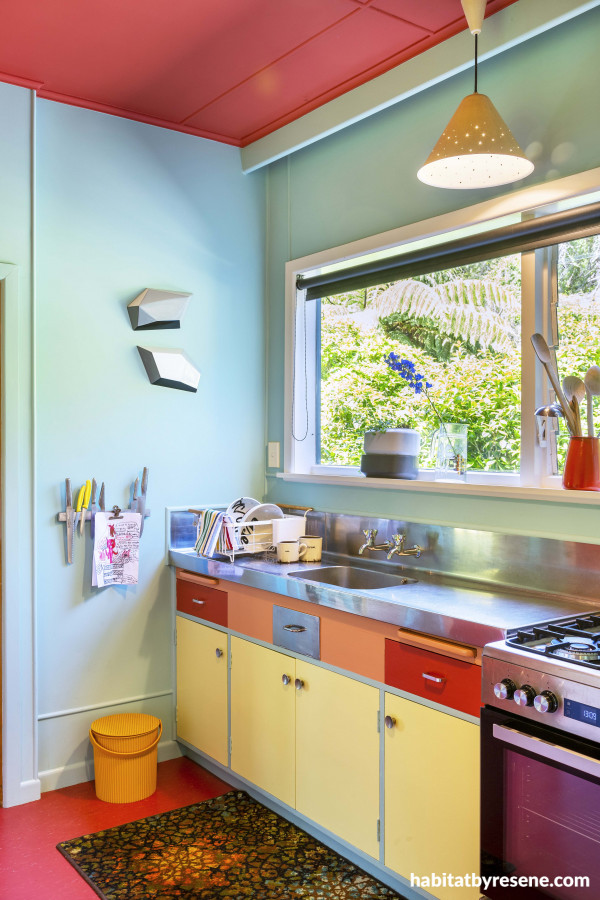
The kitchen showcases the most colours – 12 Resene paint colours were used in this room in total. The walls are painted in Resene Shadow Green. The cabinets are Resene Primrose (yellow) with colour blocks on the drawers in Resene Mexican Red, Resene Burning Sand (orange) and accents in Resene Sea Mist (green) with Resene Pearl Lusta on the window trims.
Ann and Duncan’s efforts were a big success at the Resene Total Colour Awards. In the awards, which recognise excellence in colour and paint use, the couple won a Resene Total Colour Heritage Residential Award. They also took away the colour competition’s top gong, the Resene Total Colour Master Nightingale Award, named after the Nightingale family, who founded Resene and still runs the company today.
When Ann and Duncan purchased the home in 2013, the house did not have its kaleidoscopic gush factor. The gorgeous rimu ply walls and cabinetry were mostly faithful to the original 1957 design. However, Nancy’s original Bauhaus-inspired colour scheme, which saw the walls, floor and cabinetry painted in contrasting colours, had been painted over in the blandest-of-bland whites. And yet, like a Victorian lady revealing a scandalous glance of ankle beneath her skirts, there were signs of the home’s colourful bones. Wear and tear to the white surfaces revealed hints of colour, and when Ann and Duncan were rewiring the kitchen, the home revealed its true colours: they discovered ascorbic aquas and peppy oranges beneath the light switches and power-socket covers.
“The vibrancy we discovered was so unexpected. It was truly wild,” says Duncan.

The original owner Nancy Martin was a musician and well-known artwork collector. The rimu ply walls now showcase its new owner Ann's photographic art, as well as other pieces. "This is a house that loves colour," says Ann, who has held exhibitions in the space. The blonded rimu is protected with clear coats. Use Resene Aquaclear, a clear waterborne urethane varnish or Resene Qristal Clear solventborne varnish.
Shortly after Ann and Duncan bought the home, people who had known Nancy started coming out of the woodwork; the intriguing character who created the colourful environment began to reveal herself.
An art collector and musician, Nancy is known for bringing the recorder to New Zealand, hoping the affordable instrument would introduce more children to music. She is also believed to be the first single woman in Wellington to get a mortgage and is listed on the paperwork as a ‘spinster’.
Her connection to the architect Ost was likely through music. Ost and his wife, an orchestral musician, were Jewish and fled the Nazi invasion of Europe, arriving in New Zealand as refugees in 1940.
A friend of Nancy’s discovered the architectural plans folded inside an old cookbook and passed them onto Ann and Duncan. The plans showed the bright hues on the walls shaded in colour pencil.

The bathroom walls are painted in sunny Resene Primrose and Resene Neptune with blue green cabinetry painted in Resene Sea Mist with Resene Pearl Lusta on the window trims.
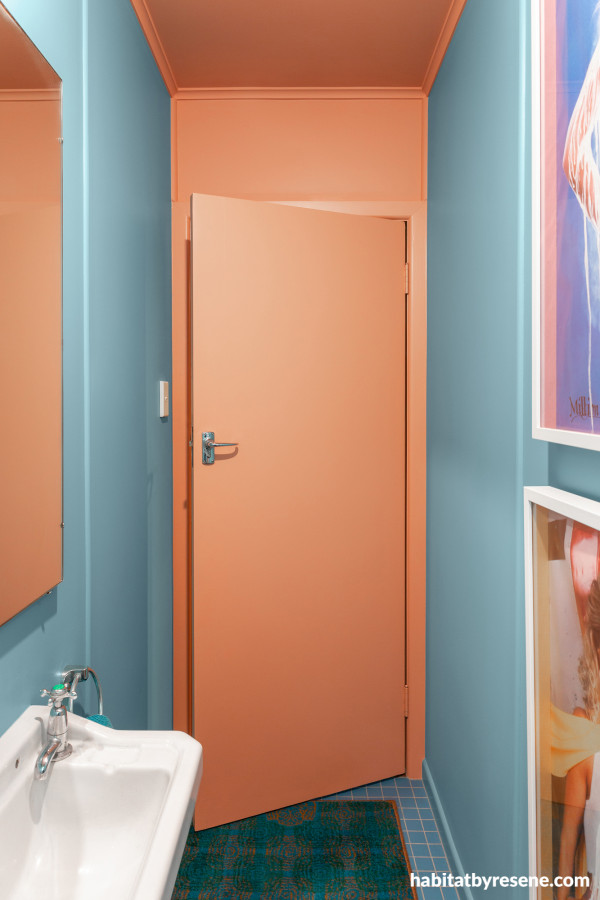
Resene Burning Sand carries from the ceiling of the bathroom down onto the door. The blue walls are Resene Neptune.
“We started getting a sense of this incredible character and this interesting collaboration between her and Ost. At first, the idea of restoring the original colours was a pipe dream. But, eventually, we saved up money and just went for it,” says Ann, an artist who was so interested in Nancy’s house she authored a book on the subject called A Spoonful of Sugar.
“It was a leap of faith as we didn’t know what it would be like to live in those colours,” says Duncan, who is a graphic designer and art director.
Duncan mocked up Ost’s plans on a computer, and then they searched for the matching colours. “We used so many testpots, but the colours weren’t quite right. The modern colours were more intense. The 1957 colours were a bit more muted than the modern shades and had a slightly ambiguous nature. The yellow would look quite green in a certain light, for instance.”
A breakthrough came when Ann posted about their colour-matching efforts on Instagram, which prompted an architect friend to share a hot tip. The friend told her that in the 1950s, there was only one colour chart to choose from – the Resene BS2660 collection. Ann and Duncan were able to use the colours from the original chart which their local Resene ColorShop tinted for them.

The ceiling of Duncan's office is painted in Resene Mexican Red. The walls are in corkboard and the window trims are Resene Pearl Lusta. The home’s exterior is painted in Resene Balderdash.
The couple decided the complicated colour scheme was a job for the professionals. One painter took one look at the paint plans and turned it down, but AAA Master Painters (www.aaapainters.nz) were intrigued by the story and excited to take on the challenging work. There are 12 different paints used in the kitchen alone, including Resene Mexican Red, Resene Burning Sand, Resene Sea Mist, Resene Primrose, Resene Pearl Lusta and Resene Shadow Green.
Living in the home is a joyful experience, says Duncan, whose favourite shade is the Resene Mexican Red on the kitchen ceiling. Ann prefers the chalky orange of Resene Burning Sand.
“When you jump out of bed in the morning and make a cup of tea, there’s a vibrancy and energy to the house. But I think the thing I like the most is the way it all comes together in quite a complex arrangement,” says Ann.

The exterior is painted in a dense and earthy blue, Resene Balderdash.
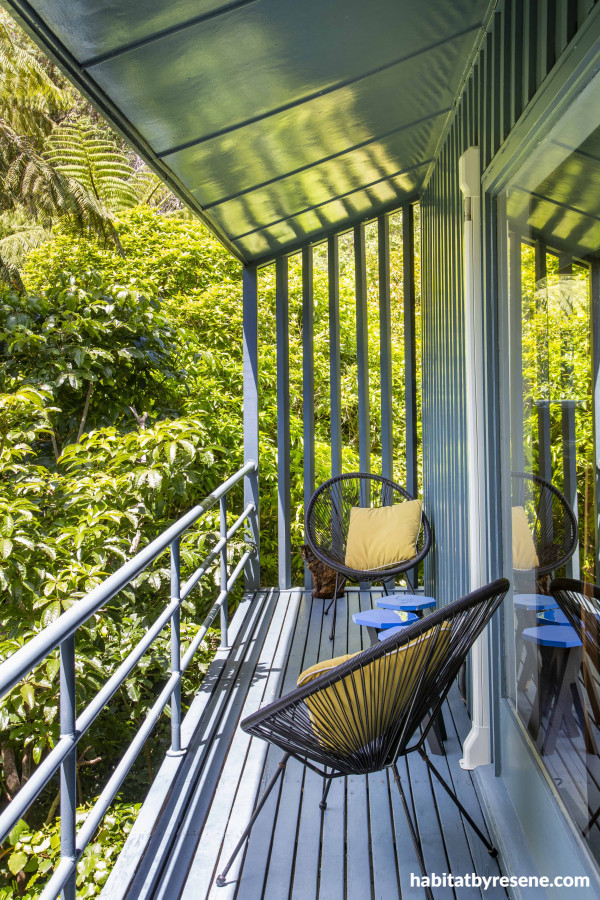
Resene Balderdash blends well with the lush greenery surrounding the house, creating a tranquil space to sit and have a morning coffee.
“It’s continually surprising, and there’s always something new to look at. My favourite part is in the toilet, where the colour from the ceiling carries through the door and to the floor.”
Duncan’s home office has Resene Mexican Red on its ceiling, and he thinks the colourful home has rubbed off on his design work. “Before living in this house, I was more tentative and unsure about using colour in my work. I think living here has made me more confident and more aware of the possibilities of different combinations.”
Ann too has dived deep into colour. Her photography exhibition at the Auckland Art Gallery in 2016, Dark Matters, featured bright walls painted in Resene paints using colours from the Karen Walker Paints collection.
“We feel incredibly privileged to live in this amazing house and to learn about its amazing story.
“There were not many women commissioning architecture in the 1950s. Nancy’s house is designed around the living areas, and there are all these feminine touches in the house, such as a built-in ironing board. I still have her old stain-removal chart and meal plans.”
Their next dilemma is tackling the outside of the house and figuring out the original paint shade.
“We had better get the scraper out,” says Ann.
design Ann Shelton www.annshelton.com
images Bonny Beattie www.bonnybeattie.com, Paul McCredie
Top tip: A good place to start when picking bold bright colour palettes is to pick up a Resene colour wheel and look to the colours on the other side of the colour wheel. Balance a vibrant hue with a dustier version of its complementary colour. When introducing contrasting or complementary colours, remember the rule of three. Try and use the accent colour in three places in the room, such as a feature wall, a vase and a cushion, so it feels part of the room and not an afterthought.
Published: 05 Feb 2024
Do you have a home full of wonderful Resene paint and colour? Send us some snaps by emailing [email protected].
the look
If you're stuck on what
colour to use or need colour
advice, try out the Resene
Ask a Colour Expert service.
the look
If you're stuck on what
colour to use or need colour
advice, try out the Resene
Ask a Colour Expert service.


